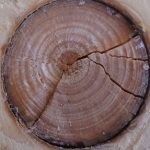
Hol-I-Wood PR
Project focus
- Time optimal process flow
- Visual position control
- Flexible production systems
Description
The correction of natural wood defects, such as resin galls or loose dead knots, interrupts the automatized production flow in timber industry. The human workforce is key for detection and classification of wood defects as well as for their correction.
The “Holonic Integration of Cognition, Communication and Control for a Wood Patching Robot”, in short “Hol-I-Wood PR”, project aims at automatizing this monotone and laborious work. The resulting innovative “wood patching”-plant is going to be integrated into the shutter board production line of our partner company.

Loose dead knot.
A multi-sensor system scans the shutter boards and collects the defect data, like position and contour of the loose dead knot given in Fig. 1. A patching robot repairs the defects by drilling a hole and sealing it with one or more patches, see Fig. 2. One wood scanner is able to supply several production lines, which are connected via junctions. In this process, a variety of optimization problems do occur, which have to be solved in real-time.
To start with, the minimum number of patches and their arrangement have to be calculated for each defect. The arrangement of the patches is severly restricted, since one has to ensure the proper connection between the patches and the shutter board.
The next task is to compute the time optimal robot path between the patch locations. This challenging combinatorial optimization problem, similar to the so-called “Travelling Salesman Problem”, moreover is time variant, since the shutter boards are flexibly allocated to the individual production lines. Consequently, the patch locations are announced to the patching robot as a (more or less) continuous flow of patch locations.
Following the allocation of the shutter board to a specific patching robot, it requests the shutter board data from a data base, moves the board by means of time optimal trajectory planning and visual position control along the desired path and places the patches.
For this purpose, position data of the board delivered by the camera network and position data acquired from standard sensors, which all have different precision and sampling time, must be merged.

Patched defect.
Due to the natural tolerances of wood and the rough production environement in saw mills, the automation design has to be robust, fault tolerant and flexible. This is achieved by modern observer and control concepts.
Furthermore, the Automation and Industrial Control Systems group of ACIN ensures maximum capacity utilization by means of flexible shutter board assignment, redirection or even buffering between the individual production lines. In case of malfunction of one or more patching robots, the shutter boards are redirected instantaneously in order to prevent unnecessarily high loss of production.
Applications
The repair of defects increases the wood’s value, regardless of the final product. In the case of shutter boards their usability is ensured, whereas in the case of furniture or window frames their appearance is improved.
Considering a more general context, similar tasks, e.g., optimal path planning, positioning of parts that are merely moved via friction or maximum capacity utilization, occur in a wide range of production chains.
Selected publications
- M. W. Hofmair, M. Melik-Merkumians, M. Böck, M. Merdan, G. Schitter, and A. Kugi, Patching process optimization in an agent-controlled timber mill, Journal of Intelligent Manufacturing, vol. 28, iss. 1, p. 69–84, 2017.
[BibTex] [Download]@Article{Hofmair14, Title = {Patching process optimization in an agent-controlled timber mill}, Author = {Hofmair, Matthias Wolfgang and Melik-Merkumians, Martin and B\"ock, M. and Merdan, M. and Schitter, G. and Kugi, A.}, Journal = {Journal of Intelligent Manufacturing}, Pages = {69--84}, Volume = {28}, Year = {2017}, Number = {1}, Doi = {10.1007/s10845-014-0962-z}, ISSN = {1572-8145}, } - M. W. Hofmair, Process Optimization and Control of a Patching Plant for Shuttering Panels, A. Kugi and K. Schlacher, Eds., Aachen: Shaker Verlag, 2016, vol. 32.
[BibTex]@Book{Hofmair16, Title = {Process Optimization and Control of a Patching Plant for Shuttering Panels}, Author = {Hofmair, M. W.}, Editor = {A. Kugi and K. Schlacher}, Publisher = {Shaker Verlag}, Year = {2016}, Address = {Aachen}, Series = {Modellierung und Regelung komplexer dynamischer Systeme}, Volume = {32}, ISBN = {978-3-8440-4745-5}, Organization = {Institute f{\"u}r Automatisierungs- und Regelungstechnik (TU Wien) und Regelungstechnik und Prozessautomatisierung (JKU Linz)}, } - M. W. Hofmair, M. Böck, and A. Kugi, Time-Optimal Trajectory Generation, Path Planning and Control for a Wood Patching Robot, in Proceedings of the 2015 IEEE Conference on Control Applications (CCA), Sydney, Australia, 2015, p. 459–465.
[BibTex]@InProceedings{Hofmair15, author = {Hofmair, Matthias Wolfgang and B\"ock, Martin and Kugi, Andreas}, title = {Time-Optimal Trajectory Generation, Path Planning and Control for a Wood Patching Robot}, booktitle = {Proceedings of the 2015 IEEE Conference on Control Applications (CCA)}, year = {2015}, publisher = {IEEE}, month = {9}, pages = {459--465}, doi = {10.1109/CCA.2015.7320672}, address = {Sydney, Australia}, }
Project partners and funding
Together with ACIN three further public research institutions as well as four industry partners from five countries of the European Union collaborated in the “Hol-I-Wood PR” project:
- Lip Opazne Plosce Bohinj Doo (Slovenia)
- Lulea Tekniska Universitet (Sweden)
- MiCROTEC (Italy)
- Springer (Austria)
- Technische Universität München (Germany)
- TTTech (Austria)
The project was funded by the 7th Framework Programme of the European Commission.
- Project acronym: Hol-I-Wood PR
- Project title: Holonic Integration of Cognition, Communication and Control for a Wood Patching Robot
- Project number: 284573